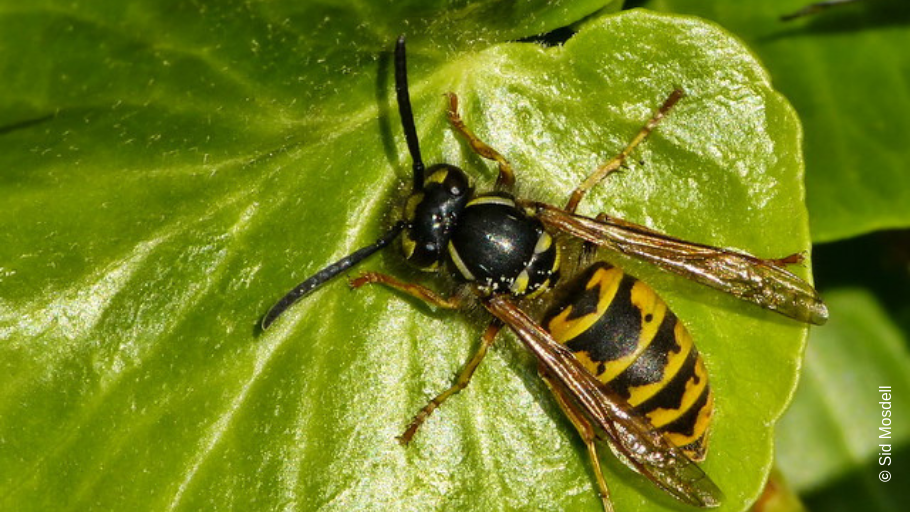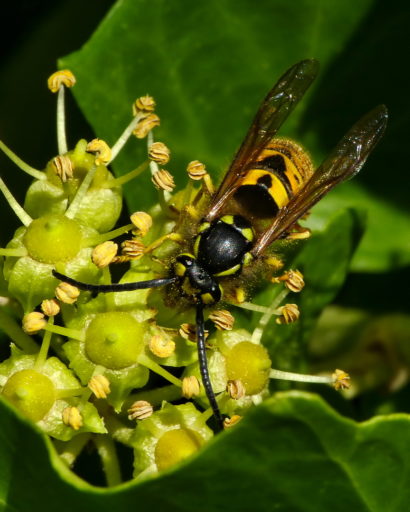Wasps and new technologies to control and eradicate them was the focus of a recent study at Victoria University of Wellington, seeking Māori Studies students’ perspectives of the social acceptability of novel biotechnologies.

“Kaupapa Māori (KM) research includes a range of methodologies that reflect, or have been repurposed to put Māori values, aspirations and decolonising principles at their centre. KM takes Māori positionality as central and normal. It seeks to build up Māori. The research methods were designed and led by two Māori researchers working alongside a Pākehā researcher. We sought out and explored a method that could support the philosophies of KM. A KM orientation meant that within these restrictions, we put our participants’ aspirations first.”
“Being mindful of the burden of ‘participant fatigue’ and ‘oversampling’ that Māori in communities experience, we designed this study to build knowledge and research capability amongst ourselves and our students. Connecting students to a real-world problem that they address in their studies contribute to their engagement, learning and success.”
New, effective and socially acceptable methods of predator control are needed, not just for wasps, but to achieve wider PF2050 goals. But how can the public decide what is socially acceptable, without engaging with the complex potential technologies?

“Aligned with the New Zealand government’s ‘Predator-Free 2050’ target for Aotearoa New Zealand, National Science Challenge: Our Biological Heritage supports research into five distinct ‘novel biotechnological controls’ of exotic wasps. A framing question within this project is which controls are considered ‘socially acceptable’ and thus suitable for further development to control and potentially eradicate introduced wasps?”
“How can the public answer this question without first engaging with complex technologies? Can they develop and express an informed view that still reflects their ‘gut’ reactions and unique positions? To model and explore the views of an ‘informed public’, university students in Māori studies engaged in reflection, writing and mapping activities; choice and ranking exercises; Q Method; and focus group interviews.”
So what is Q Method?
“Q Method is not hypothesis-driven, but a systematic way to measure and compare subjectivities or points of view. It is a useful technique when viewpoints are wide ranging. Q Method explores the range of views on a subject, and how these relate to each other.”
“This study is just the second to explore how Q Method fits with the ideologies of kaupapa Māori research. Q Method deals in subjectivities, allowing for diverse perspectives to emerge. The presentation of statements that have been carefully chosen to represent multiple voices promotes reflection and discussion on topics that may not otherwise arise. Absolute numbers are less significant compared to overall pattern comparison.”
Like the wider, Aotearoa/New Zealand community generally, Māori perspectives are broad-ranging, meaning they are likely to represent a broad range of possible social positions, as previous research has confirmed.
“For instance, research with Māori communities found 7 uniquely identifiable positions on biotechnology. Māori concerns about biotechnology seem mostly rooted in an explicit tikanga basis or sovereignty-related concerns such as biocolonialism and health of the land. Health benefits are often cited as a reason for accepting biotechnology research and outcomes.”
“This research is part of a National Science Challenge: Our Biological Heritage project that investigates five different ‘novel biotechnologies’. These are emerging biotechnologies under development that have the potential to control and possibly eradicate exotic social wasps from Aotearoa NZ. The mission statement for the project seeks ‘socially acceptable’ next-generation technologies that are targeted and affordable.”
The university students learnt about and considered how they felt about those 5 new biotechnologies:
- Artificial Pheromones: Pheromones are chemical substances produced and released to communicate with (or affect the behaviour and physiology of) members within the same species.
- Trojan mites for biological control: A mite, Pneumolaelaps niutirani, was discovered in 2011 by a New Zealand researcher. Wasps nests infested with these mites were found to be generally smaller, diseased, and less aggressive than mite-free nests.
- RNA Interference (RNAi): RNA interference (RNAi) is a gene silencing mechanism triggered by providing double-stranded RNA. When ingested into insects, this RNA can lead to death or affect the viability of the target pest. RNAi is a natural cellular defence process.
- Trojan female: In many populations, naturally occurring mutations occur in mutations inherited mitochondrial DNA. These mutation means females produce sterile males, without affecting the female carrying them.
- Gene drive ‘Gene drives’ rely on the genetic modification of an organism’s DNA by scientists. Gene drives dramatically promote the inheritance of a particular gene to increase its frequency in a population.
Historically, social perceptions of biotechnologies such as genetic modification have not been particularly positive.
“In 2004, the Royal Commission on Genetic Modification (RCGM) effectively advocated that NZ ‘proceed with caution’ on these technologies. But this ran counter to religious, spiritual and cultural concerns, and a strong backlash occurred from amongst academic and public communities alike. This included opposition from Māori to the technology, but also to the way the debate was conducted and decisions made. As co-signatories to the Treaty of Waitangi, along with the Crown, Māori have mechanisms through which to negotiate with the New Zealand government along its governance and decision-making practices. These precede the much-discussed notion of a Social Licence to Operate although key principles in Social License, such as trust are critical to public support and engagement.”
Public engagement in conversations on emerging pest control technologies is a priority of the National Science Challenge: Our Biological Heritage project.
“The actual mechanisms for social engagement are evolving and as the key challenge for the future, need much work to tease out who and how to engage, and how to communicate and inform.”
“As a way to explore the likelihood of new biotechnological control methods being accepted, the research seeks opinions on ‘pests’ generally, wasps in particular, existing control methods, novel biotechnological controls, and the social and political context that both enable and constrain the conversations. These questions required developing and using a wide array of methodologies that were consistent with kaupapa Māori positioning. Q Method can give particular insight when there is a multitude of perspectives. The paper thus reports on a variety of findings relating to the viewpoints of intelligent laypeople with perceptive, thoughtful and culturally-informed views. While our focus is on wasps, results inform the PF2050 project and the control or eradication of other pest species.”
Sixteen students were involved in the study.
“The Māori studies students learning about wasps and biotechnological controls constitute an informed but generally not science-trained audience. Of the 16 who were willing to be involved, 1 was interviewed individually and 12 were split evenly into four focus groups, for a total of 13 participants. Five were female and eight male. Six were mature students (over 40 years of age, or with children).”
“This represents a more male, and more mature cohort than generally seen in Māori studies. Five participants were at postgraduate and 8 at a senior undergraduate level. All participants were familiar with Māori studies discourse, comfortable in kaupapa Māori settings, and had at least a listening fluency in te reo Māori. The participants represent a broad range of iwi (tribes), some are active leaders in student politics, and some have connections to and/ or leadership roles in their home communities. 11 primarily identified as Māori and two as non-Māori.”
Q Method analysis distinguished three ‘factors’, describing unique viewpoints among the interviewees: those who see the potential of biotechnologies, those who are in doubt about them and those in a position of trust in scientists.
“In terms of the kinds of control that participants find acceptable, all of the 9 key attributes were represented: for instance that a control should be humane, targeted, not harm other animals and that rigorous testing is needed in order to reduce risk.”
Another clear theme that emerged was a preference for a control that is perceived as natural.
“Human intervention is seen as less invasive if the intervention is patterned off a naturally occurring process, particularly if that process could have occurred within the natural course of things. This new attribute for an acceptable pest control method has the unique potential to be facilitated by the more sophisticated and precise understandings that modern science brings, allowing better understanding and replication of natural systems.”
Overall, the group saw potential in new biotechnologies for wasps but are wary of political, economic and social decision-making mechanisms.
“Finally, what room is there for social, cultural and spiritual issues to operate within the ‘problem-research-solution-apply’ narrative that dominates scientific enquiry, and arguably, the premise of this research? The cohort empathised with many issues related to the broader social ecosystem, including a consensus that they mistrust government, and varying levels of trust in scientists’ ethicality and ability to communicate.”
“This is a real dilemma given that the engine powering science in Aotearoa is largely government-led, and that a business-corporate funded science is likely to be even more distrusted. While these participants might see the potential of biotechnologies, giving a degree of social licence to continue investigating new technologies for biodiversity conservation, that is tempered by the machinations of a socio-political engine that remains largely out of their control.”
This research is published in Kōtuitui: New Zealand Journal of Social Sciences Online and is freely available.

